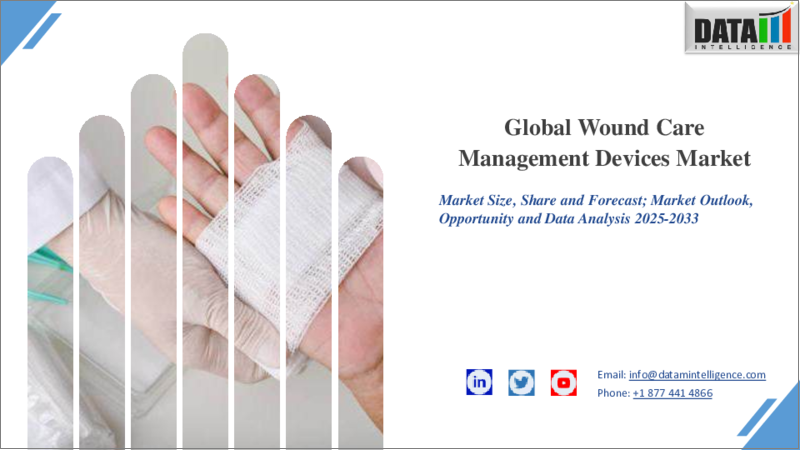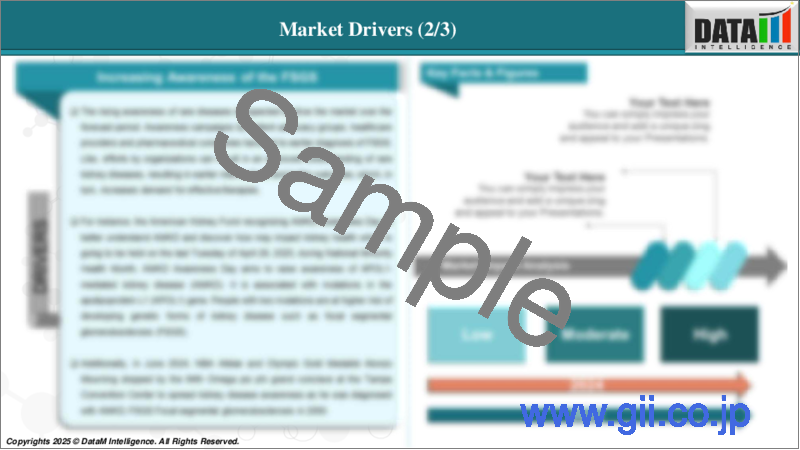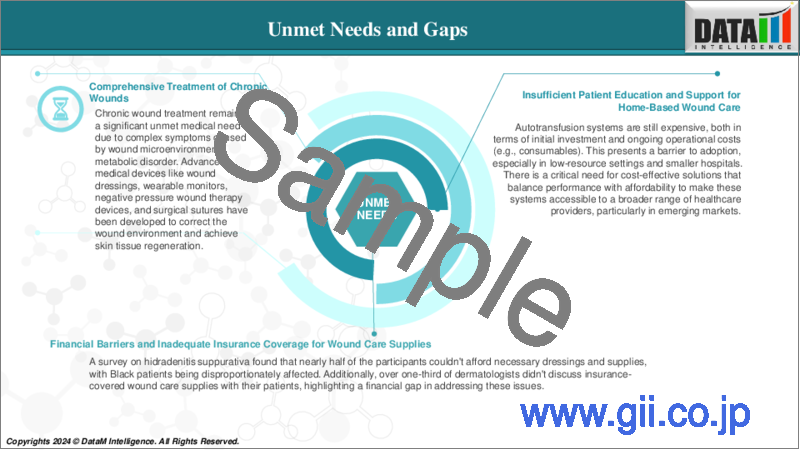|
|
市場調査レポート
商品コード
1678773
創傷ケア管理デバイスの世界市場 (2025年~2033年)Global Wound Care Management Devices Market - 2025-2033 |
||||||
カスタマイズ可能
適宜更新あり
|
|||||||
| 創傷ケア管理デバイスの世界市場 (2025年~2033年) |
|
出版日: 2025年03月11日
発行: DataM Intelligence
ページ情報: 英文 220 Pages
納期: 即日から翌営業日
|
- 全表示
- 概要
- 目次
世界の創傷ケア管理デバイス市場は、2024年に206億9,000万米ドルに達し、2033年には290億米ドルに達すると予測され、予測期間2025年にはCAGR 3.8%で成長すると予測されています。
創傷ケア管理デバイスは、急性創傷、慢性創傷、外科的創傷を含む様々なタイプの創傷を治療、治癒、予防するために設計された医療用具です。早期治癒、感染リスクの低減、合併症の最小化により患者の転帰を改善します。この市場には、NPTシステム、保湿性ドレッシング材、生体工学製品、手術用機器などの高度なソリューションが含まれます。慢性疾患の増加、人口の高齢化、それに伴う外科手術の増加に伴い、革新的な創傷ケア管理デバイスに対する需要が高まっています。
市場力学:
促進要因と抑制要因
慢性創傷の増加
創傷ケア管理デバイス市場は、糖尿病性足潰瘍、褥瘡、静脈性下腿潰瘍などの慢性創傷の発生率の増加により活況を呈しています。人口の高齢化、糖尿病の有病率の上昇、肥満などの要因が、治癒しない創傷の増加につながっています。効果的な治癒と合併症の予防には、先進的なソリューションが必要です。特に北米や欧州のような先進地域では、このような需要が革新的な機器の需要を牽引しています。
例えば、5年間でメディケア受給者の創傷有病率は820万人から1,050万人へと13%増加しました。最も増加したのは65歳未満でした。最も変化が大きかったのは動脈性潰瘍、皮膚障害、外傷性創傷でした。支出は3つの方法にかかわらず減少し、最も保守的な方法では297億米ドルから225億米ドルに減少しました。
高度創傷治療製品の高額費用
陰圧創傷治療システムや生体工学的ドレッシング材など、先進的な創傷治療製品や治療法のコストが高いことが、特に中低所得地域における市場成長の妨げとなっています。また、償還政策や従来の創傷ケア製品に制限があるため、医療提供者や患者は従来の選択肢を選ぶ傾向にあります。
目次
第1章 分析手法と分析範囲
第2章 定義と概要
第3章 エグゼクティブサマリー
第4章 市場力学
- 影響要因
- 促進要因
- 慢性創傷の増加
- 抑制要因
- 高度な創傷ケア製品の高コスト
- 機会
- 影響分析
- 促進要因
第5章 戦略的洞察と業界展望
- 市場のリーダーと先駆者
- 新たな先駆者と主要企業
- 最大の売上を誇るブランドを確立したリーダー
- 確立された製品を持つ市場リーダー
- CXOの視点
- 最新の開発とブレークスルー
- ケーススタディ/進行中の研究
- 規制と償還の情勢
- 北米
- 欧州
- アジア太平洋
- ラテンアメリカ
- 中東・アフリカ
- ポーターのファイブフォース分析
- サプライチェーン分析
- 特許分析
- SWOT分析
- アンメットニーズとギャップ
- 市場参入と拡大のための推奨戦略
- シナリオ分析:ベストケース・ベースケース・ワーストケースの予測
- 価格分析と価格市場力学
- キーオピニオンリーダー (KOL)
第6章 製品種類別
- 先進的創傷ケア機器
- 外科用創傷ケア機器
- 従来型創傷ケア機器
第7章 総省の種類別
- 慢性創傷
- 急性創傷
第8章 エンドユーザー別
- 病院・診療所
- 在宅医療
- 長期介護施設
第9章 地域別
- 北米
- 米国
- カナダ
- メキシコ
- 欧州
- ドイツ
- 英国
- フランス
- スペイン
- イタリア
- その他欧州地域
- 南米
- ブラジル
- アルゼンチン
- その他南米地域
- アジア太平洋
- 中国
- インド
- 日本
- 韓国
- その他アジア太平洋地域
- 中東・アフリカ
第10章 競合情勢
- 競合シナリオ
- 市況・シェア分析
- 企業合併・買収 (M&A) 分析
第11章 企業プロファイル
- Smith & Nephew plc
- 企業概要
- 製品ポートフォリオ
- 製品説明
- 製品の主要業績評価指標(KPI)
- 製品販売の実績・予測
- 製品販売量
- 財務概要
- 企業の収益
- 収益シェア:地域別
- 収益予測
- 主な発展
- 企業合併・買収 (M&A)
- 主な製品開発活動
- 規制当局の承認等
- SWOT分析
- 3M Company
- Cardinal Health, Inc.
- Medtronic plc
- Coloplast A/S
- ConvaTec Group plc
- Johnson & Johnson Services, Inc.
- Molnlycke Health Care AB
- Hollister Incorporated
- Medline Industries, Inc
- Similar data will be provided for each market player.
- MiMedx Group, Inc
- パイプライン製品の説明
- 製品の主要業績評価指標(KPI)
- 主な活動
- 市場参入のタイムライン
- 製品普及率
- 売上予測と予測
- Talley Group Ltd
- DeRoyal Industries, Inc.
- 各企業に対しても同様のデータが提供されます。
第12章 付録
The Global wound care management devices market reached US$ 20.69 billion in 2024 and is expected to reach US$ 29.00 billion by 2033, growing at a CAGR of 3.8% during the forecast period 2025-2033.
Wound care management devices are medical tools designed to treat, heal, and prevent various types of wounds, including acute, chronic, and surgical ones. They improve patient outcomes by promoting faster healing, reducing infection risks, and minimizing complications. The market includes advanced solutions like NPT systems, moisture-retentive dressings, bioengineered products, and surgical devices. With the rising incidence of chronic diseases, aging populations, and the subsequent increase in surgical procedures, the demand for innovative wound care management devices is growing.
Market Dynamics: Drivers & Restraints
Increasing Incidence of Chronic Wounds
The market for wound care management devices is booming due to the increasing incidence of chronic wounds like diabetic foot ulcers, pressure ulcers, and venous leg ulcers. Factors like an aging population, rising prevalence of diabetes, and obesity contribute to the increasing incidence of non-healing wounds. Advanced solutions are needed for effective healing and preventing complications. This demand, especially in developed regions like North America and Europe, is driving the demand for innovative devices.
For instance, over a 5-year period, Medicare beneficiaries with wounds increased from 8.2 million to 10.5 million, with a 13% increase in wound prevalence. The largest increase was seen in those aged <65 years. The largest changes were in arterial ulcers, skin disorders, and traumatic wounds. Expenditures decreased regardless of the three methods used, with a reduction of $29.7 billion to $22.5 billion for the most conservative method.
High Cost of Advanced Wound Care Products
The high cost of advanced wound care products and therapies, such as negative pressure wound therapy systems and bioengineered dressings, hinders market growth, especially in low and middle-income regions. Limited reimbursement policies and traditional wound care products also limit their adoption, leading healthcare providers and patients to opt for traditional options.
Segment Analysis
The global wound care management devices market is segmented based on product type, wound type, end user and region.
Product Type:
The advanced wound care devices in the product type segment are expected to dominate with the highest market share.
The advanced wound care devices segment holds a major portion of the wound care management devices market share and is expected to continue to hold a significant portion during the forecast period.
Advanced wound care devices, such as negative pressure wound therapy systems, advanced dressings, and bioactive products, are crucial for treating complex and chronic wounds like diabetic foot ulcers, pressure ulcers, and surgical wounds. They facilitate faster healing, reduce infection risks, and minimize patient discomfort. Demand for these devices is growing in North America and Europe due to their effectiveness in promoting wound healing, especially for patients with underlying conditions like diabetes and cardiovascular diseases. As the demand rises, manufacturers are actively involved in the launch of advanced products.
For instance, in February 2025, Biomiq Inc., a leading Canadian provider of advanced wound care solutions, introduced PureGel, a super-oxidizing nano-hydrogel. This Class II medical device offers a long-lasting, non-cytotoxic solution for wound management, marking a new era in advanced wound care.
Geographical Analysis
North America is expected to hold a significant position in the wound care management devices market share.
North America holds a substantial position in the wound care management devices market and is expected to hold most of the market share in the future. This dominance is fuelled by the increasing prevalence of chronic wounds like diabetic foot ulcers, pressure ulcers, and venous leg ulcers. The region's high diabetes and obesity rates necessitate advanced wound care solutions. The presence of established healthcare infrastructure, increasing healthcare expenditure, and advanced wound care technologies drive market growth.
For instance, in May 2024, AVITA Medical, a regenerative medicine company, received FDA approval for its premarket approval supplement for the RECELL GO System, a next-generation autologous cell harvesting device that uses a patient's own skin's regenerative properties to treat thermal burn wounds and full-thickness skin defects.
Competitive Landscape
The major global players in the wound care management devices market include Smith & Nephew plc, 3M Company, Cardinal Health, Inc., Medtronic plc, Coloplast A/S, ConvaTec Group plc, Johnson & Johnson Services, Inc., Molnlycke Health Care AB, Hollister Incorporated, Medline Industries, Inc., and among others.
Key Developments
- In September 2024, Solventum launched the V.A.C. Peel and Place Dressing, an integrated dressing and drape that can be applied in less than two minutes and worn by patients for up to seven days. Traditional dressings for negative pressure wound therapy take longer, require a multi-step process, and may need to be changed three times a week.
Why Purchase the Report?
- Pipeline & Innovations: Reviews ongoing clinical trials, product pipelines, and forecasts upcoming advancements in medical devices and pharmaceuticals.
- Product Performance & Market Positioning: Analyze product performance, market positioning, and growth potential to optimize strategies.
- Real-World Evidence: Integrates patient feedback and data into product development for improved outcomes.
- Physician Preferences & Health System Impact: Examines healthcare provider behaviors and the impact of health system mergers on adoption strategies.
- Market Updates & Industry Changes: This covers recent regulatory changes, new policies, and emerging technologies.
- Competitive Strategies: Analyze competitor strategies, market share, and emerging players.
- Pricing & Market Access: Reviews pricing models, reimbursement trends, and market access strategies.
- Market Entry & Expansion: Identifies optimal strategies for entering new markets and partnerships.
- Regional Growth & Investment: Highlights high-growth regions and investment opportunities.
- Supply Chain Optimization: Assesses supply chain risks and distribution strategies for efficient product delivery.
- Sustainability & Regulatory Impact: Focuses on eco-friendly practices and evolving regulations in healthcare.
- Post-market Surveillance: Uses post-market data to enhance product safety and access.
- Pharmacoeconomics & Value-Based Pricing: Analyzes the shift to value-based pricing and data-driven decision-making in R&D.
The global Wound Care Management Devices market report delivers a detailed analysis with 61 key tables, more than 59 visually impactful figures, and 220 pages of expert insights, providing a complete view of the market landscape.
Target Audience 2024
- Manufacturers: Pharmaceutical, Medical Device, Biotech Companies, Contract Manufacturers, Distributors, Hospitals.
- Regulatory & Policy: Compliance Officers, Government, Health Economists, Market Access Specialists.
- Product Type & Innovation: AI/Robotics Providers, R&D Professionals, Clinical Trial Managers, Pharmacovigilance Experts.
- Investors: Healthcare Investors, Venture Fund Investors, Pharma Marketing & Sales.
- Consulting & Advisory: Healthcare Consultants, Industry Associations, Analysts.
- Supply Chain: Distribution and Supply Chain Managers.
- Consumers & Advocacy: Patients, Advocacy Groups, Insurance Companies.
- Academic & Research: Academic Institutions.
Table of Contents
1. Methodology and Scope
- 1.1. Research Methodology
- 1.2. Research Objective and Scope of the Report
2. Definition and Overview
3. Executive Summary
- 3.1. Snippet by Product Type
- 3.2. Snippet by Wound Type
- 3.3. Snippet by End User
- 3.4. Snippet by Region
4. Dynamics
- 4.1. Impacting Factors
- 4.1.1. Drivers
- 4.1.1.1. Increasing Prevalence of Chronic Wounds
- 4.1.2. Restraints
- 4.1.2.1. High Cost of Advanced Wound Care Products
- 4.1.3. Opportunity
- 4.1.4. Impact Analysis
- 4.1.1. Drivers
5. Strategic Insights and Industry Outlook
- 5.1. Market Leaders and Pioneers
- 5.1.1. Emerging Pioneers and Prominent Players
- 5.1.2. Established leaders with largest selling Brand
- 5.1.3. Market leaders with established Product
- 5.2. CXO Perspectives
- 5.3. Latest Developments and Breakthroughs
- 5.4. Case Studies/Ongoing Research
- 5.5. Regulatory and Reimbursement Landscape
- 5.5.1. North America
- 5.5.2. Europe
- 5.5.3. Asia Pacific
- 5.5.4. Latin America
- 5.5.5. Middle East & Africa
- 5.6. Porter's Five Forces Analysis
- 5.7. Supply Chain Analysis
- 5.8. Patent Analysis
- 5.9. SWOT Analysis
- 5.10. Unmet Needs and Gaps
- 5.11. Recommended Strategies for Market Entry and Expansion
- 5.12. Scenario Analysis: Best-Case, Base-Case, and Worst-Case Forecasts
- 5.13. Pricing Analysis and Price Dynamics
- 5.14. Key Opinion Leaders
6. By Product Type
- 6.1. Introduction
- 6.1.1. Market Size Analysis and Y-o-Y Growth Analysis (%), By Product Type
- 6.1.2. Market Attractiveness Index by Product Type
- 6.2. Advanced Wound Care Devices*
- 6.2.1. Introduction
- 6.2.2. Market Size Analysis and Y-o-Y Growth Analysis (%)
- 6.3. Surgical Wound Care Devices
- 6.4. Traditional Wound Care Devices
7. By Wound Type
- 7.1. Introduction
- 7.1.1. Market Size Analysis and Y-o-Y Growth Analysis (%), By Wound Type
- 7.1.2. Market Attractiveness Index by Wound Type
- 7.2. Chronic Wounds*
- 7.2.1. Introduction
- 7.2.2. Market Size Analysis and Y-o-Y Growth Analysis (%)
- 7.3. Acute Wounds
8. By End User
- 8.1. Introduction
- 8.1.1. Market Size Analysis and Y-o-Y Growth Analysis (%), By End User
- 8.1.2. Market Attractiveness Index, By End User
- 8.2. Hospitals and Clinics*
- 8.2.1. Introduction
- 8.2.2. Market Size Analysis and Y-o-Y Growth Analysis (%)
- 8.3. Home Healthcare
- 8.4. Long-term Care Facilities
9. By Region
- 9.1. Introduction
- 9.1.1. Market Size Analysis and Y-o-Y Growth Analysis (%), By Region
- 9.1.2. Market Attractiveness Index, By Region
- 9.2. North America
- 9.2.1. Introduction
- 9.2.2. Key Region-Specific Dynamics
- 9.2.3. Market Size Analysis and Y-o-Y Growth Analysis (%), By Product Type
- 9.2.4. Market Size Analysis and Y-o-Y Growth Analysis (%), By Wound Type
- 9.2.5. Market Size Analysis and Y-o-Y Growth Analysis (%), By End User
- 9.2.6. Market Size Analysis and Y-o-Y Growth Analysis (%), By Country
- 9.2.6.1. U.S.
- 9.2.6.2. Canada
- 9.2.6.3. Mexico
- 9.3. Europe
- 9.3.1. Introduction
- 9.3.2. Key Region-Specific Dynamics
- 9.3.3. Market Size Analysis and Y-o-Y Growth Analysis (%), By Product Type
- 9.3.4. Market Size Analysis and Y-o-Y Growth Analysis (%), By Wound Type
- 9.3.5. Market Size Analysis and Y-o-Y Growth Analysis (%), By End User
- 9.3.6. Market Size Analysis and Y-o-Y Growth Analysis (%), By Country
- 9.3.6.1. Germany
- 9.3.6.2. U.K.
- 9.3.6.3. France
- 9.3.6.4. Spain
- 9.3.6.5. Italy
- 9.3.6.6. Rest of Europe
- 9.4. South America
- 9.4.1. Introduction
- 9.4.2. Key Region-Specific Dynamics
- 9.4.3. Market Size Analysis and Y-o-Y Growth Analysis (%), By Product Type
- 9.4.4. Market Size Analysis and Y-o-Y Growth Analysis (%), By Wound Type
- 9.4.5. Market Size Analysis and Y-o-Y Growth Analysis (%), By End User
- 9.4.6. Market Size Analysis and Y-o-Y Growth Analysis (%), By Country
- 9.4.6.1. Brazil
- 9.4.6.2. Argentina
- 9.4.6.3. Rest of South America
- 9.5. Asia-Pacific
- 9.5.1. Introduction
- 9.5.2. Key Region-Specific Dynamics
- 9.5.3. Market Size Analysis and Y-o-Y Growth Analysis (%), By Product Type
- 9.5.4. Market Size Analysis and Y-o-Y Growth Analysis (%), By Wound Type
- 9.5.5. Market Size Analysis and Y-o-Y Growth Analysis (%), By End User
- 9.5.6. Market Size Analysis and Y-o-Y Growth Analysis (%), By Country
- 9.5.6.1. China
- 9.5.6.2. India
- 9.5.6.3. Japan
- 9.5.6.4. South Korea
- 9.5.6.5. Rest of Asia-Pacific
- 9.6. Middle East and Africa
- 9.6.1. Introduction
- 9.6.2. Key Region-Specific Dynamics
- 9.6.3. Market Size Analysis and Y-o-Y Growth Analysis (%), By Product Type
- 9.6.4. Market Size Analysis and Y-o-Y Growth Analysis (%), By Wound Type
- 9.6.5. Market Size Analysis and Y-o-Y Growth Analysis (%), By End User
10. Competitive Landscape
- 10.1. Competitive Scenario
- 10.2. Market Positioning/Share Analysis
- 10.3. Mergers and Acquisitions Analysis
11. Company Profiles
Key Market Players
- 11.1. Smith & Nephew plc*
- 11.1.1. Company Overview
- 11.1.2. Product Portfolio
- 11.1.2.1. Product Description
- 11.1.2.2. Product Key Performance Indicators (KPIs)
- 11.1.2.3. Historic and Forecasted Product Sales
- 11.1.2.4. Product Sales Volume
- 11.1.3. Financial Overview
- 11.1.3.1. Company Revenue's
- 11.1.3.2. Geographical Revenue Shares
- 11.1.3.3. Revenue Forecasts
- 11.1.4. Key Developments
- 11.1.4.1. Mergers & Acquisitions
- 11.1.4.2. Key Product Development Activities
- 11.1.4.3. Regulatory Approvals, etc.
- 11.1.5. SWOT Analysis
- 11.2. 3M Company
- 11.3. Cardinal Health, Inc.
- 11.4. Medtronic plc
- 11.5. Coloplast A/S
- 11.6. ConvaTec Group plc
- 11.7. Johnson & Johnson Services, Inc.
- 11.8. Molnlycke Health Care AB
- 11.9. Hollister Incorporated
- 11.10. Medline Industries, Inc
- Similar data will be provided for each market player.
Emerging Market Players
- 11.11. MiMedx Group, Inc*
- 11.11.1. Pipeline Products Description
- 11.11.2. Product Key Performance Indicators (KPIs)
- 11.11.3. Key Activities
- 11.11.4. Market Entry Timelines
- 11.11.5. Product Penetration Rate
- 11.11.6. Sales Estimation and Projections
- 11.12. Talley Group Ltd
- 11.13. DeRoyal Industries, Inc.
- Similar data will be provided for each market player.
LIST NOT EXHAUSTIVE
12. Appendix
- 12.1 About Us and Services
- 12.2 Contact Us






